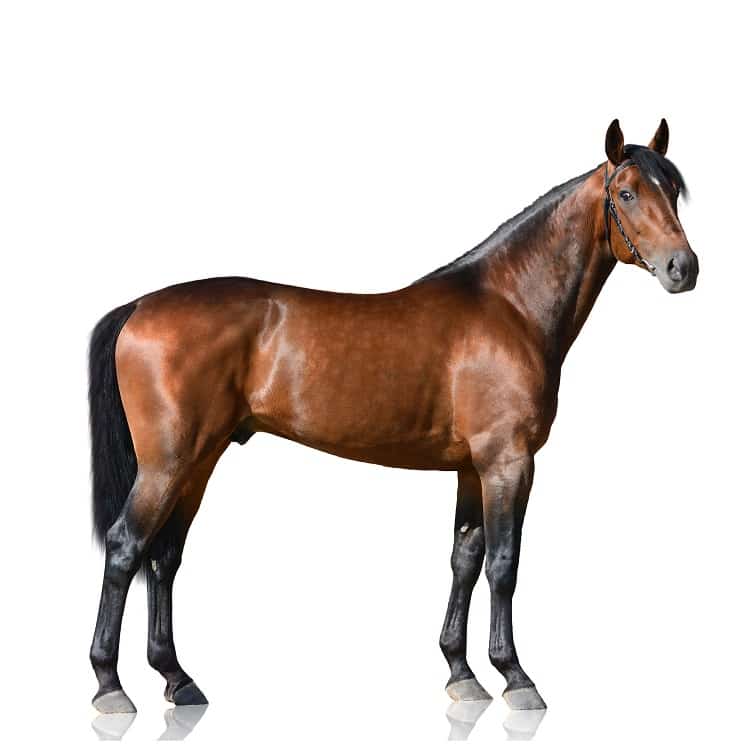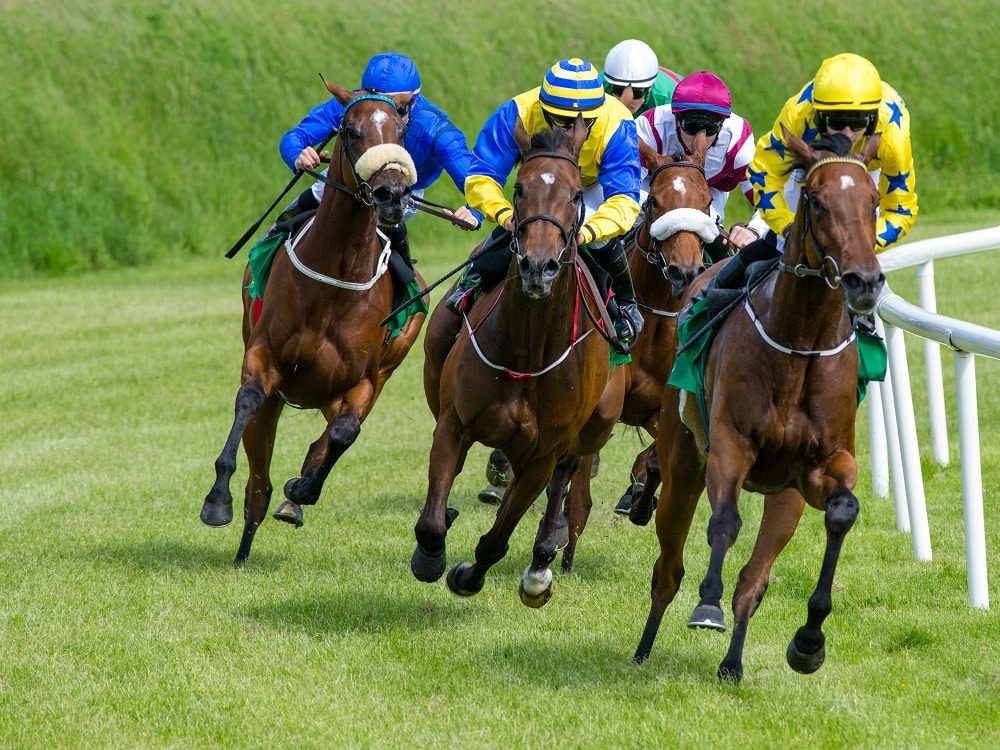
Vital Stats
| WEIGHT: | 450kg – 550kg |
| HEIGHT: | 15 hands – 17 hands |
| LIFE EXPECTANCY: | 25 – 35 years |
| BEST FOR: | horse racing, show jumping, dressage and more |
| ORIGIN: | England |
Order now for delivery on Monday 22nd April
Most commonly seen on the racecourse, the Thoroughbred horse is considered a hot-blooded breed with spirit, agility, sensitivity and speed. Originating in 17th and 18th century England from three imported stallions, the Thoroughbred horse quickly spread throughout the world and today there are millions of this horse breed in existence.
While they are most commonly used in horse racing, Thoroughbreds are also popular for show jumping, dressage, hunting, polo and more. Their origins may lie in the UK, however today it is the United States which is the world’s largest producer of Thoroughbred horses.


| WEIGHT: | 450kg – 550kg |
| HEIGHT: | 15 hands – 17 hands |
| LIFE EXPECTANCY: | 25 – 35 years |
| BEST FOR: | horse racing, show jumping, dressage and more |
| ORIGIN: | England |
The thoroughbred horse has its origins in 17th and 18th century England, at a time when horse racing was growing in popularity and breeding horses to race was an increasingly common practice. To create the Thoroughbred, three stallions of Barb, Turkomen and Arab descent were imported from the Middle East to Great Britain and bred with native mares. These stallions were the Bryerly Turk, the Darley Arabian, and the Godolphin Arabian.
As a result of this practice of importing horses from Eastern bloodlines to mate with native mares, the General Stud Book (GSB) was created in 1791. Only horses who can trace their origins back to these three Stallions may appear in the GSB.
Improvement of the Thoroughbred for racing continued throughout the centuries, and the breed has also been crossbred to improve or even create other breeds, such as the American Quarter Horse and the Anglo-Arabian.
Today, the Thoroughbred continues its work on the race tracks as well as taking part in a multitude of other equestrian sports. There are millions of Thoroughbred horses across the globe.
Thoroughbreds stand at around 16 hands high, although it is not uncommon for the height of a Thoroughbred horse to range from 15hh to 17hh. Thoroughbred horses weigh in at between 450kg – 550kg.
The athletic Thoroughbred has a tall, slim appearance with a broad chest and a short back. Bred for speed, this horse breed displays a number of physical characteristics which facilitate this such as a lean body, long legs and a chiselled head.
The most common Thoroughbred horse colours are black, brown, gray, bay and chestnut, while roan and palomino Thoroughbred horses are seen in the United States, albeit on a rarer occasion.
Solid coloured Thoroughbred horses are preferred by breed registries, which do not recognise Thoroughbred horses with more than one colour on the body; white markings on the face and body are allowed but uncommon.
Thoroughbred horses are happy to eat a regular equine diet of quality hay, grain, vegetables and fruits. An athletic horse used for sport, the Thoroughbred has a fast metabolism and so can often require higher quantities of horse food to keep up with their high energy usage.
Perhaps the most recognisable characteristic of the Thoroughbred horse is its impressive speed! These popular race horses can reach up to around 44 miles per hour, with a Thoroughbred by the name of Winning Brew holding the title of the fastest racehorse with a speed of 43.97mph over two furlongs.
Thoroughbred horses are also recognisable for their lean, athletic appearance; and solid colours.
As a breed, Thoroughbred horses are intelligent and energetic, with a strong work ethic. They can also be bold and spirited, making them better suited to a more experienced equestrian rather than a beginner.
As well as excelling as race horses, the Thoroughbred’s temperament makes them great all-rounders; and they are also seen in dressage rings and out on the trails.
There is also a nurture element to the Thoroughbred horse’s temperament: due to years spent on the racecourse, they can be easily spooked and may require more work when retraining for general riding. However, there are organisations geared towards helping ex-racehorses find a happy home, including the RoR; and when managed correctly this can be incredibly fulfilling.
Due in large part to their role as racehorses, Thoroughbreds are susceptible to a number of equine health issues. Pushed to their limits on the racecourse, the accident rates among Thoroughbreds are high, resulting in life changing and even fatal injuries. Accidents aside, many Thoroughbred racing horses are unable to remain sound and may develop stress fractures or bone chips throughout their careers.
Thoroughbred horses are also prone to health issues including bleeding from the lungs, which can be the result of excessive exercise or excessive inbreeding. Low fertility is also a concern, while some Thoroughbred horses have abnormally small hearts, or an unbalanced hoof to body size ratio which can contribute to lameness.
When it comes to grooming a Thoroughbred horse, appearance is one key consideration – and performance is another. Following a regular equine grooming regime will keep your Thoroughbred horse looking glossy and healthy. Bear in mind that Thoroughbred horses tend to have thinner skin, so you may need to be more gentle when brushing.
Grooming a Thoroughbred racehorse often requires a stringent regime. Hoof care is key when grooming a Thoroughbred horse for racing: regular inspections are important to ensure hooves are free from dirt and pebbles, as well as to look out for signs of cracked hooves. It is also important to keep a Thoroughbred horse’s hair trimmed to an acceptable length, as well as to keep it out of their eyes when racing.
The typical lifespan of a healthy Thoroughbred horse is between 25 – 30 years.
The most obvious reason to choose a Thoroughbred is for racing: these athletic horses excel in this area, and have been bred for this very purpose. They are incredibly fast, with an intelligent and hard working temperament which makes them easy to train in the right hands.
Aside from racing, Thoroughbreds are also popular in a range of equestrian sports including dressage and show jumping. There are also a number of charities set up to encourage equestrians to choose an ex-race horse such as a Thoroughbred: owning an ex-racehorse can be both rewarding and challenging, however with the right home they can find a new lease of life and are great for leisure riding, hacking, and companionship.
